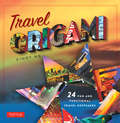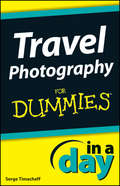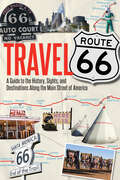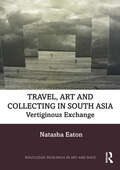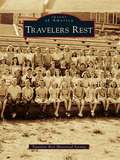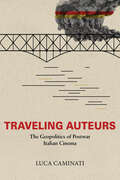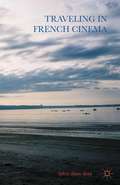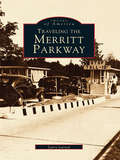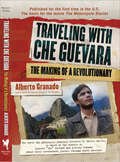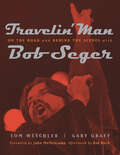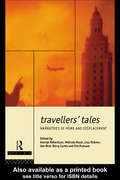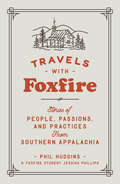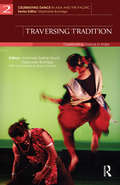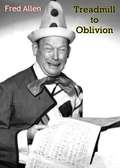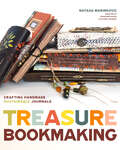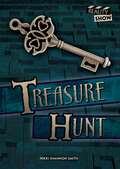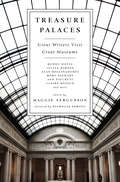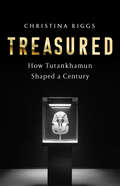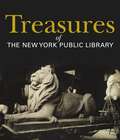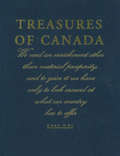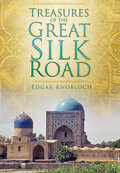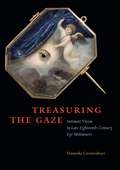- Table View
- List View
Travel Origami
by Cindy NgIn her new book, Travel Origami, author Cindy Ng shows you how to take the paper souvenirs you collect on your travels and turn them into beautiful and useful folded origami objects that serve as visible mementoes! Use those postcards, street maps, tickets and souvenirs and convert them into artful memories that can last a lifetime. Whether you are a world traveler or a local vacationer, Travel Origami gives you 24 easy-to-fold origami projects that are fun to make and fabulous to display in your home. Foolproof step-by-step instructions show you how to fold your paper collections into special items you can wear, carry, hang on your wall, or give to a traveling companion as a special keepsake. 24 fun and functional travel keepsakes include: Lampshade Photo frame Jewelry Wreath This book is the perfect way to stretch your adventures into hours of memory-making fun while reminiscing with family and friends.
Travel Origami
by Cindy NgMake flashy origami projects out of postcards, photos and other travel keepsakes with this easy origami book. In Travel Origami, author Cindy Ng shows you how to take the paper souvenirs you collect on your travels and turn them into beautiful and useful folded origami objects that serve as visible mementoes! Use those postcards, street maps, tickets and souvenirs and convert them into artful memories that can last a lifetime. Use it to craft eye-catching origami for your friends, to decorate your room—or as a wonderful gift for paper craft lovers. All of the folds are simple enough to be origami-for-kids projects and are a great way to learn origami. None of the projects require paint or glue so just grab some origami paper and start folding right away! This origami book contains: 120 page, full-color book 24 fun and functional origami projects Step-by-step instructions Colorful diagrams and photos Origami basics and tips Travel Origami is the perfect way to stretch your adventures into hours of memory-making fun while reminiscing with family and friends. Origami projects include: Comic Strip Bracelet Metro Card Holder New Kind of Envelope Modern Money Ring And many more. . .
Travel Origami
by Cindy NgMake flashy origami projects out of postcards, photos and other travel keepsakes with this easy origami book.In Travel Origami, author Cindy Ng shows you how to take the paper souvenirs you collect on your travels and turn them into beautiful and useful folded origami objects that serve as visible mementoes! Use those postcards, street maps, tickets and souvenirs and convert them into artful memories that can last a lifetime.Use it to craft eye-catching origami for your friends, to decorate your room--or as a wonderful gift for paper craft lovers. All of the folds are simple enough to be origami-for-kids projects and are a great way to learn origami. None of the projects require paint or glue so just grab some origami paper and start folding right away!This origami book contains: 120 page, full-color book 24 fun and functional origami projects Step-by-step instructions Colorful diagrams and photos Origami basics and tipsTravel Origami is the perfect way to stretch your adventures into hours of memory-making fun while reminiscing with family and friends.Origami projects include: Comic Strip Bracelet Metro Card Holder New Kind of Envelope Modern Money Ring And many more...
Travel Photography In A Day For Dummies (In A Day For Dummies)
by Serge TimacheffTake better travel shots on your next vacation with this terrific, 100-page e-book! From pro to hobbyist, from short weekends to dream vacations, every photographer wants to be able to capture memorable and compelling travel photos. Now you can hit the road with this fast-paced, In A Day For Dummies e-book that really zeros in on how to best capture eye-popping travel photos. Find out how to set your camera, make adjustments on the fly, prepare for all kinds of light--even get great shots with your smartphone. You'll go through this handy e-book in a day, and capture photos for a lifetime. Focuses on techniques for capturing fantastic travel photos, no matter where you are or what kind of camera Covers setting the camera for the shot, making adjustments on the fly, lighting and composition, using a smartphone camera, and editing and sharing your photos Includes a "Beyond the book" online component, where you can find step-by-step tutorials, videos, and a bonus lesson on creating a high-dynamic range travel photo Online extras also include a photo book, how to make money selling your photos, and a gallery of unique travel photos to inspire you Get Travel Photography In A Day For Dummies, grab your camera, and hit the road!
Travel Route 66: A Guide to the History, Sights, and Destinations Along the Main Street of America
by Jim HinckleyTake the ultimate road trip along America’s longest attraction and discover the cities, restaurants, roadside attractions, and more—from Illinois to California.Long one of America’s most cherished byways, Route 66 remains a popular tourist attraction and travel route for thousands of travelers every year. While stretches of the once-glorious road have been paved over or bypassed by the interstates, the journey from Chicago to Santa Monica along the path of the “double six” remains chock-full of unique roadside attractions, spectacular natural landscapes, and fascinating historical landmarks. Communities throughout each of the eight states touched by the “Main Street of America” —Illinois, Missouri, Kansas, Oklahoma, Texas, New Mexico, Arizona, and California—have embraced this vital piece of American history and offer a vast array of opportunities to experience the grandeur as well as the lost innocence of the glory days of Route 66.In Travel Route 66, Route 66 expert and enthusiast Jim Hinckley provides detailed descriptions and itineraries that allow travelers of all ages and inclinations to explore the myriad wonders to be found along the highway’s 2,500 miles. In addition to specific recommendations for places to visit, eat, and spend the night, Hinckley presents history for the highway and its attractions and suggests detours and daytrips off the beaten path, all while providing a vivid picture of the road that has long captured the imaginations of travelers from throughout the world. Illustrated with a wealth of color photos and vintage memorabilia, Travel Route 66 is a practical and entertaining guide to the America’s Mother Road.
Travel, Art and Collecting in South Asia: Vertiginous Exchange (Routledge Research in Art and Race)
by Natasha EatonTravel, Art and Collecting in South Asia questions what are ideas of vertiginous collecting, art-making and museums as expanded fields, including wonder houses and missionary museums (or museobuses) in Britain and South Asia. If the historiography of British India has privileged photography and the 'Imperial Picturesque', the emphasis here is on the formation of a creole modernity, one that considers the relationship between art and labour, including pearlescence and pearl fishing in Sri Lanka, and the iconoclastic/fetish debates and forms of collecting amongst missionaries. Eaton explores these themes alongside the genealogies and modernities of white(ness) in contemporary curating and amateur female practice, and how the museobus or museum as a unique object has informed the work of contemporary artist group Raqs Media Collective. This book will be of interest to scholars in art history, Asian history, and imperial and colonial history.
Travelers Rest (Images of America)
by Travelers Rest Historical SocietyThe little town in upstate South Carolina, embraced by nearby Paris Mountain and the foothills of the Blue Ridge Mountains, is intriguing by its name alone, "Travelers Rest." It sits at the foot of the Appalachian Mountains, yet it is only a half-day's journey from the Atlantic Ocean. This village has always been a place where travelers stopped. Situated on a crossroad of Cherokee trade trails, it became a rest stop for drovers moving their livestock over the mountains. Inns and rest camps developed, and the town of Travelers Rest grew around them. Scots-Irish settled the former Cherokee lands, and patriots were ceded land for Revolutionary War service. In 1887, the new railroad afforded access to factories and markets and improved transportation for tourists. Travelers Rest is proud of its history and eagerly looks forward to a thriving future built on a solid foundation of education, commerce, and community activities.
Traveling Auteurs: The Geopolitics of Postwar Italian Cinema (New Directions in National Cinemas)
by Luca CaminatiWhat tensions characterized the relationships between cinema, European Leftists, and emerging postcolonial ideologies after World War II? In Traveling Auteurs, author Luca Caminati analyzes the work of influential Italian filmmakers Roberto Rossellini, Pier Paolo Pasolini, and Michelangelo Antonioni as they engaged politically and aesthetically with the global landscapes and politics of the Cold War period. As documentaries, the films considered in this book record specific manifestations of political sensibilities of the twentieth century. As bodies of work, they reveal that the traveling auteurs who made them were symptomatic actors in complex geopolitical networks. As cultural objects reflecting and shaping contemporaneous debates, they provoke a complex afterlife at home and abroad. In the three chapters dedicated to Rossellini in India, Pasolini in Africa and the Middle East, and Antonioni in China, Caminati pays particular attention both to the reception that these films had in the countries where they were shot and to their legacies in Italian film history. As it follows the entanglements of filmmakers, artists, and activists involved as allies or direct witnesses to momentous political change, this book sheds new light on anticolonial struggles, the reaffirmation of the Non-Aligned Movement, and the consolidation of the Chinese Communist Party.
Traveling in French Cinema
by Sylvie Blum-ReidTravel narratives abound in French cinema since the 1980s. This study delineates recurrent travel tropes in films such as departures and returns, the chase, the escape, nomadic wandering, interior voyages, the unlikely travel, rituals, pilgrimages, migrants' narratives and emergencies, women's travel, and healing narratives.
Traveling the Merritt Parkway (Images of America)
by Larry LarnedSince 1938, when the Merritt's first 7-mile section was opened to traffic, millions have shared a fascination for Connecticut's Merritt Parkway and its bridges. Discover the beginnings of this groundbreaking advance in American travel in Traveling the Merritt Parkway. This exciting collection of images preserves and pays tribute to the history of the Merritt. Opened for 38 miles on September 2, 1940, it became known throughout Fairfield County, Connecticut, as the "Queen of Parkways." A survey made in 1928 called for a two-lane macadam highway to run from Stratford to Greenwich. With $1 million of state money, construction started on the Merritt Highway in 1932. This pictorial history explores the construction of the parkway as well as the little known parent highway for which the earliest bridges were constructed, including White Plains Road in the town of Trumbull.
Traveling with Che Guevara: The Making of a Revolutionary (Shooting Script Ser.)
by Alberto GranadoPublished for the first time in the U.S.—one of the two diaries on which the movie The Motorcycle Diaries is based—the moving and at times hilarious account of Che Guevara and Alberto Granado's eight-month tour of South America in 1952.In 1952 Alberto Granado, a young doctor, and his friend Ernesto Guevara, a 23-year-old medical student from a distinguished Buenos Aires family, decided to explore their continent. They set off from Cordoba in Argentina on a Norton 500cc motorbike and traveled through Chile, Peru, Colombia, and Venezuela. The duo's adventures vary from the suspenseful (stowing away on a cargo ship, exploring Incan ruins) to the comedic (falling in love, drinking, fighting...) to the serious (volunteering as firemen and at a leper colony). They worked as day laborers along the way—as soccer coaches, medical assistants, and furniture movers. The poverty and exploitation of the native population started the process that was to turn Ernesto—the debonair, fun-loving student—into Che, the revolutionary who had a profound impact on the history of several nations.Originally published in Spanish in Cuba in 1978, the first English translation was published by Random House UK in 2003. The movie, based on Granado's and Che's diaries, directed by Walter Salles (Central Station, Behind the Sun), was produced by Robert Redford and others. Shown at the Sundance Film Festival, it generated great reviews and a frenzied auction for distribution rights, which was won by Focus Features. Granado, now 82, was a consultant to Salles during the production. 10 b/w photos.
Travelin’ Man: On the Road and Behind the Scenes with Bob Seger
by John Mellencamp Gary Graff Kid Rock Tom WeschlerNow in paperback: a photo-driven insider's look at Bob Seger's career from the early days to his breakthrough as a world-famous musician.
Travellers' Tales: Narratives of Home and Displacement (FUTURES: New Perspectives for Cultural Analysis)
by Tim Putnam George Robertson Melinda Mash Lisa Tickner Jon Bird Barry CurtisAn investigation into the future of travelling in a world where boundaries are shifting and dissolving. Amongst the issues covered are politics and identity, history and narration and the representation of other cultures.
Travels with Foxfire: Stories of People, Passions, and Practices from Southern Appalachia
by Phil Hudgins Jessica PhillipsSince 1972, the Foxfire books have preserved and celebrated the culture of Southern Appalachia for hundreds of thousands of readers. In Travels with Foxfire, native son Phil Hudgins and Foxfire student Jessica Phillips travel from Georgia to the Carolinas, Tennessee to Kentucky, collecting the stories of the men and women who call the region home. Across more than thirty essays, we discover the secret origins of stock car racing, the story behind the formation of the Great Smoky Mountains National Park, the vanishing art of gathering wild ginseng, and the recipes of an award-winning cookbook writer. We meet bootleggers and bear hunters, game wardens and medicine women, water dowsers, sculptors, folk singers, novelists, record collectors, and home cooks—even the world’s foremost “priviologist”—all with tales to tell. A rich compendium of the collected wisdom of artists, craftsmen, musicians, and moonshiners, Travels with Foxfire is a joyful tribute to the history, the geography, and the traditions that define Appalachian living.
Traversing Tradition: Celebrating Dance in India (Celebrating Dance in Asia and the Pacific)
by Stephanie Burridge Urmimala Sarkar MunsiDance occupies a prestigious place in Indian performing arts, yet it curiously, to a large extent, has remained outside the arena of academic discourse. This book documents and celebrates the emergence of contemporary dance practice in India. Incorporating a multidisciplinary approach, it includes contributions from scholars, writers and commentators as well as short essays and interviews with Indian artists and performers; the latter add personal perspectives and insights to the broad themes discussed. Young Indian dance artists are courageously charting out new trajectories in dance, diverging from the time-worn paths of tradition. The classical forms of Bharatnatyam, Kathak, Odissi and Manipuri, to name a few, are rich resources for choreographers exploring contemporary dance. This volume speaks about their struggles of working within and outside tradition as they grapple with national and international audience expectations as well as their own values and sense of identity. The artists represented here continue to question the uneasy relationship that exists between the insular world of dance and outside reality. Simultaneously, they are actively creating new dance languages that are both articulate in a performative context and demand examination by researchers and critics.
Treadmill to Oblivion
by Fred AllenFans of classic comedy and Old Time Radio will be enthralled by Fred Allen's autobiographical tale of his early days in radio. From the host of a small comedy-variety show to national fame with Allen's Alley, here is the story of his trials, tribulations, and ultimate successes as one of the great radio comedians--not to mention one of the great wits--of the 20th century!
Treasure Bookmaking: Crafting Handmade Sustainable Journals
by Natasa MarinkovicDivine Diary DIYs for the Innovative Crafter#1 Best Seller in Book Making & Binding and ScrapbookingWith journal making projects, book binding techniques, and journal prompts, this Treasure Book Making guide has everything you need. Get ready to create personal journals by hand easily—without any extra book-binding tools!An affordable craft. Hobbies tend to require a big investment, but Author Natasa Marinkovic, creator of popular YouTube channel Treasure Books, focuses on upcycling the available materials around us. Learn how to make beautiful journals—without purchasing book-binding tools, use what you have! With the things you have at home, create projects that are both useful and beautiful. Fall into the world of book binding. This junk-journaling-how-to gives readers all of the details on how to make a book through step-by-step creative projects that will save you space and get rid of house clutter. This diary DIY is the ultimate space for your creativity to bloom and grow! Inside, you'll find:Illustrations and tips to jumpstart your creativity on DIY books Easy-to-follow instructions to structure and make a book for journaling and scrap keeping Lists of accessible materials to use—such as cereal boxes, scraps of paper, and everyday items like buttons and moreIf you enjoyed learning how to craft a book in Making Handmade Books, Hand Bookbinding, or journaling books like My Soul Pages, you’ll love Treasure Book Making.
Treasure Hunt (Reality Show)
by Nikki Shannon SmithWhen Jazmine and Jason's younger brother's bike gets stolen, they team up to compete in a treasure hunt TV competition so they can use the prize money to replace it. But when they realize they have different strengths and different competing styles, the treasure hunt becomes more challenging than they ever imagined. Will they be able to work together long enough to take home the prize?
Treasure Palaces: Great Writers Visit Great Museums
by The Economist Maggie Fergusson Nicholas SerotaIn this exuberant celebration of the world's museums, great and small, revered writers like Ann Patchett, Julian Barnes, Neil Gaiman, and more tell us about their favorite museums, including the Lower East Side Tenement Museum in New York, the Musée Rodin in Paris, and Tate Modern in London. These essays, collected from the pages of The Economist's Intelligent Life magazine, reveal the special hold that some museums have over us all.In his ode to the Museum of Anthropology in Xalapa, Mexico, the great novelist and essayist Carlos Fuentes writes, "Museums, like lovers, can lose their charms. But the next time can always be the first time.” William Boyd visits the Leopold Museum in Vienna-a shrine to his favorite artist, Egon Schiele, whom Boyd first discovered on a postcard as a University student. In front of her favorite Rodins, Allison Pearson recalls a traumatic episode she suffered at the hands of a schoolteacher following a trip to the Musée in Paris. Neil Gaiman admires the fantastic world depicted in British outsider artist Richard Dadd's "The Fairy Feller's Master-Stroke,” a tiny painting that also decorated the foldout cover of a Queen album, housed in the Victorian room of Tate Britain's Pre-Raphaelite collection. Ann Patchett fondly revisits Harvard University's Museum of Natural History-which she discovered at 19, while in the throes of summer romance with a biology student named Jack.In Search of the Originals is a treasure trove of wonders, a tribute to the diversity and power of the museums, the safe-keepers of our world's most extraordinary artifacts, and an intimate look into the deeply personal reveries we fall into when before great art.
Treasured Possessions: Indigenous Interventions into Cultural and Intellectual Property
by Haidy GeismarWhat happens when ritual practitioners from a small Pacific nation make an intellectual property claim to bungee jumping? When a German company successfully sues to defend its trademark of a Māori name? Or when UNESCO deems ephemeral sand drawings to be "intangible cultural heritage"? In Treasured Possessions, Haidy Geismar examines how global forms of cultural and intellectual property are being redefined by everyday people and policymakers in two markedly different Pacific nations. The New Hebrides, a small archipelago in Melanesia managed jointly by Britain and France until 1980, is now the independent nation-state of Vanuatu, with a population that is more than 95 percent indigenous. New Zealand, by contrast, is a settler state and former British colony that engages with its entangled Polynesian and British heritage through an ethos of "biculturalism" that is meant to involve an indigenous population of just 15 percent. Alternative notions of property, resources, and heritage--informed by distinct national histories--are emerging in both countries. These property claims are advanced in national and international settings, but they emanate from specific communities and cultural landscapes, and they are grounded in an awareness of ancestral power and inheritance. They reveal intellectual and cultural property to be not only legal constructs but also powerful ways of asserting indigenous identities and sovereignties.
Treasured: How Tutankhamun Shaped a Century
by Christina RiggsA bold new history of the discovery of King Tut and the seismic impact it left on modern society. When it was discovered in 1922, in an Egypt newly independent of the British Empire, the 3,300-year-old tomb of Tutankhamun sent shockwaves around the world. The boy-king became a household name overnight and kickstarted an international obsession that continues to this day. From pop culture and politics to tourism and the heritage industry, it&’s impossible to imagine the past century without the discovery of Tutankhamun – yet so much of the story remains untold. In Treasured, Christina Riggs weaves compelling historical analysis with tales of lives touched, or changed forever, by an encounter with the boy-king. Who remembers that Jacqueline Kennedy first welcomed the young pharaoh to America? That a Tutankhamun revival in the 1960s helped save the ancient temples of Egyptian Nubia? Or that the British Museum&’s landmark Tutankhamun exhibition in 1972 remains its most successful ever? But not everything about &‘King Tut&’ glitters: tours of his treasures in the 1970s were linked to Big Oil, his mummified remains have been exploited in the name of science, and accounts of his tomb&’s discovery exclude Egyptian archaeologists. Treasured offers a bold new history of the young pharaoh who has as much to tell us about our world as his own.
Treasures
by New York Public LibraryA lavishly illustrated book to accompany the New York Public Library's exhibition of the priceless treasures in its archivesInside the walls of its three research library buildings, The New York Public Library is a palace of wonders containing diverse collections of over 46 million objects including rare books, maps, paintings, prints, sculpture, photographs, films, recorded sound, furniture, ephemera, rare and important historical documents, and more. In honor of the NYPL’s 125th anniversary, the library is opening its first ever permanent exhibition in the exquisite Gottesman Hall on the first floor of its iconic 42nd Street Building: The Polonsky Exhibition of The New York Public Library’s Treasures. Treasures is the official book to accompany the exhibition: a sumptuous four-color volume that showcases the depth and breadth of the library’s holdings. Filled with the creations of history-makers and influencers who changed the world, Treasures includes such diverse items from NYPL’s collections as the Declaration of Independence written in Thomas Jefferson’s hand; the original Bill of Rights; Charles Dickens’s desk; George Washington’s handwritten farewell address; manuscript material from authors such as Maya Angelou, Charles Dickens, T.S. Eliot, Jack Kerouac, Vladimir Nabokov, Mary Shelley, Virginia Woolf, and many others; a Gutenberg Bible; Malcolm X’s briefcase; the original Winnie-The-Pooh dolls; the only existing letter from Christopher Columbus to King Ferdinand regarding his discovery, and a Sumerian cuneiform tablet ca. 2300 BC. Treasures is The New York Public Library’s gift to the world.
Treasures Of Canada
by Alan Samuel John De VisserThis tome is an extensive record of Canadas treasures including art, architecture, historical sites, and spots of natural beauty.
Treasures of the Great Silk Road
by Edgar KnoblochTurkestan – the great landmass of Central Asia and Western China – is an intriguing meeting point of civilizations. Four major invasions – Greek, Arab, Mongol and Russian – together with Persian, Turkic and Chinese cultural influences, have made their mark on this vast and sometime forbidding region. The Great Silk Road ran to the West through it, while nomad and urban peoples combined over the centuries to produce a cultural flowering under Timur and his successors in the late medieval and early modern periods, through a rich profusion of artistic and architectural styles and ornament. In this comprehensive account of the culture and history of Central Asia, Edgar Knobloch describes the main centres of our human civilization. He spices the text with quotations from the works of contemporary travellers, while providing an expert’s commentary on the archaeological, architectural and decorative features of the sites he describes. The stunning and evocative photographs are supplemented by numerous maps, incorporating the recent developments in the region’s borders and frontiers. With up-to-date information on borders, check points and visas, Treasures of the Great Silk Road should appeal not only to scholars and those interested in the great cultural heritage of this region, but also to travellers to the region.
Treasuring the Gaze: Intimate Vision in Late Eighteenth-Century Eye Miniatures
by Hanneke GrootenboerThe end of the eighteenth century saw the start of a new craze in Europe: tiny portraits of single eyes that were exchanged by lovers or family members. Worn as brooches or pendants, these minuscule eyes served the same emotional need as more conventional mementoes, such as lockets containing a coil of a loved one’s hair. The fashion lasted only a few decades, and by the early 1800s eye miniatures had faded into oblivion. Unearthing these portraits in Treasuring the Gaze, Hanneke Grootenboer proposes that the rage for eye miniatures—and their abrupt disappearance—reveals a knot in the unfolding of the history of vision. Drawing on Alois Riegl, Jean-Luc Nancy, Marcia Pointon, Melanie Klein, and others, Grootenboer unravels this knot, discovering previously unseen patterns of looking and strategies for showing. She shows that eye miniatures portray the subject’s gaze rather than his or her eye, making the recipient of the keepsake an exclusive beholder who is perpetually watched. These treasured portraits always return the looks they receive and, as such, they create a reciprocal mode of viewing that Grootenboer calls intimate vision. Recounting stories about eye miniatures—including the role one played in the scandalous affair of Mrs. Fitzherbert and the Prince of Wales, a portrait of the mesmerizing eye of Lord Byron, and the loss and longing incorporated in crying eye miniatures—Grootenboer shows that intimate vision brings the gaze of another deep into the heart of private experience. With a host of fascinating imagery from this eccentric and mostly forgotten yet deeply private keepsake, Treasuring the Gaze provides new insights into the art of miniature painting and the genre of portraiture.
